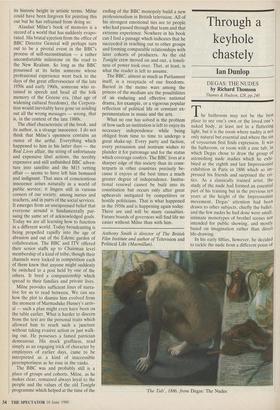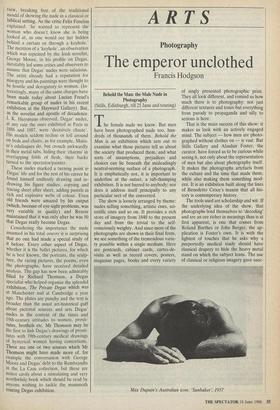Through a keyhole chastely
Ian Dunlop
DEGAS: THE NUDES by Richard Thomson
Thames & Hudson, £28, pp.240
The bathroom may not be the best place to see one's own or the loved one's naked body, at least. not in a flattering light, but it is the room where nudity is not only natural but essential and where the sin of voyeurism first finds expression. It was the bathroom, or room with a zinc tub, in which Degas chose to draw the group of astonishing nude studies which he exhi- bited at the eighth and last Impressionist exhibition in Paris in 1886 which so im- pressed his friends and surprised the cri- tics. As a classically trained artist, the study of the nude had formed an essential part of his training but in the previous ten years at the height of the Impressionist movement, Degas' attention had been drawn to other subjects, chiefly the ballet, and the few nudes he had done were small. intimate monotypes of brothel scenes not intended for public showing, and mostly based on imagination rather than direct life-drawing.
In his early fifties, however, he decided to tackle the nude from a different point of
'The Tub', 1886, from Degas: The Nudes
view, breaking free of the traditional mould of showing the nude in a classical or biblical setting. As the critic Felix Fenelon explained: 'he wanted to represent the woman who doesn't know she is being looked at, as one would see her hidden behind a curtain or through a keyhole.' The mention of a 'keyhole', an observation which was repeated by the Irish novelist, George Moore, in his profile on Degas, inevitably led some critics and observers to assume that Degas' nudes were salacious. The artist already had a reputation for misogyny and his paintings were thought to be hostile and derogatory to women. (In- terestingly, many of the same charges have been made today about Lucian Freud's remarkable group of nudes in his recent exhibition at the Hayward Gallery). But, as the novelist and apostle of decadence. J. K. Huysmans observed, Degas' nudes, at any rate the ones exhibited in Paris in 1886 and 1887, were 'decisively chaste'. His models seldom recline or loll around on beds and chairs, as for example, Matis- se's odalisques do, but crouch awkwardly in their metal tubs, hiding their 'charms' in overlapping folds of flesh, their backs turned to the spectator/painter.
These nudes marked a turning point it Degas' life and for the rest of his career he found himself endlessly drawing and re- drawing his figure studies, copying and tracing sheet after sheet, adding pastels in rich and explosive webs of colour. Even old friends were amazed by his output (which, because of eye-sight problems, was very variable in quality) and Renoir maintained that it was only after he was 50 that Degas really become Degas.
Considering the importance the nude assumed in his total oeuvre it is surprising that no one had made a special study of it before. Every other aspect of Degas, whether it is the ballet pictures, for which he is best known, the portraits, the sculp- ture, the racing pictures, the poems, even the photographs, have received detailed analysis. The gap has now been admirably filled by Richard Thomson, a Degas specialist who helped organise the splendid exhibition, The Private Degas which was at Manchester and at Cambridge a year ago. The plates are punchy and the text is broader than the usual art-historical guff about pictorial sources and sets Degas' nudes in the context of the times and 19th-century attitudes to women, prosti- tutes, brothels etc. Mr Thomson may be the first to link Degas's drawings of prosti- tutes with 19th-century medical drawings of hysterical women having contortions. There are one or two sources which Mr Thomson might have made more of, for example the conversation with George Moore and Degas' debt to the Rembrandts in the. La Caze collection, but these are minor cavils about a stimulating and very worthwhile book which should. be read by anyone wishing to tackle the mammoth touring Degas exhibition.



















































 Previous page
Previous page